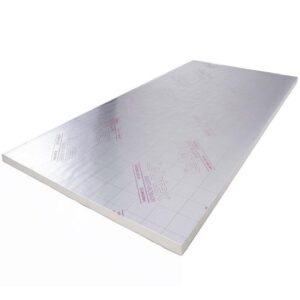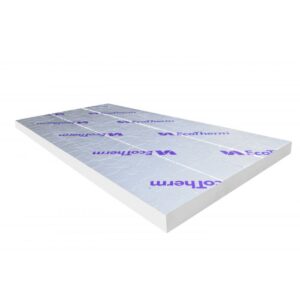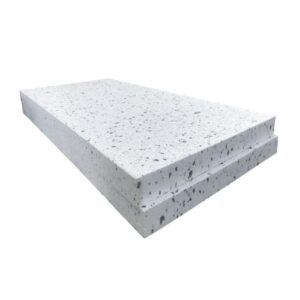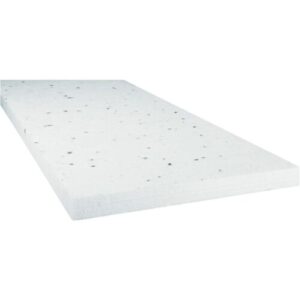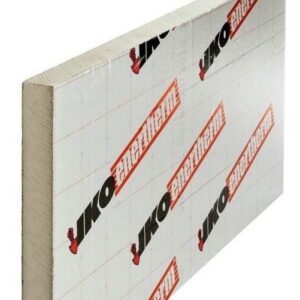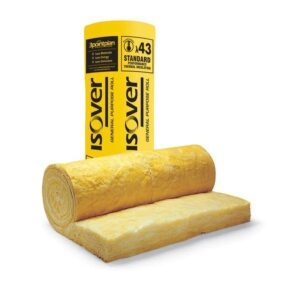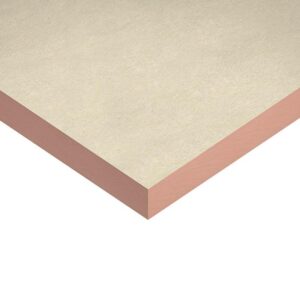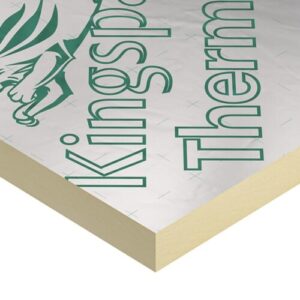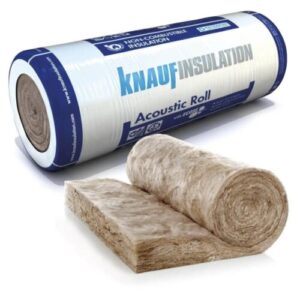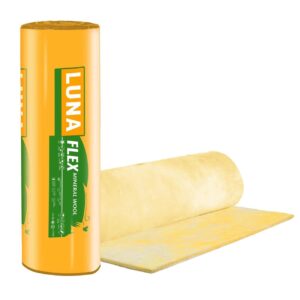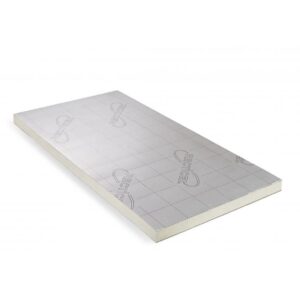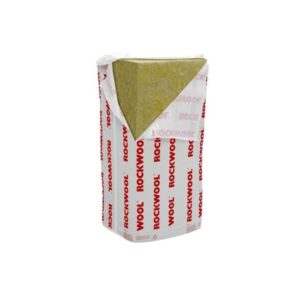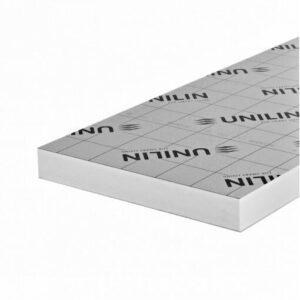100mm Kingspan ThermaFloor TF70 PIR represents high performance floor thermal insulation. The boards are built of polyisocyanurate (PIR), and consist of a closed cell foam that provides excellent thermal insulation. TF70 PIR is generally applied for various works, especially for solid or suspended floors, to improve the energy efficiency of buildings and reduce heat loss.
Floor Insulation
Floor insulation comes in handy when you need to insulate the floorboards or when you want to seal the spaces between skirting boards and floors. Pick from our wide range of floor insulation boards from the UK’s leading manufacturers and brands such as
- Recticel Eurothane GP
- Ecotherm Eco-Versal
- Kingspan TF70/K103
- Jablite Polystyrene EPS
- Mannok PIR Insulation
Our experienced team also provides sound and sensible advice regarding the materials and installation. For consultation and product recommendations call us on 02033 187 316 and we will be more than happy to help.
What is Floor Insulation
Floor insulation is insulation fixed beneath your home’s floorboards. The main purpose is to minimize the loss of heat through the floor. Note that more than 20% of heat is lost through the floor into the ground.
The right time to install floor insulation boards is during the fixing of a new floor, even though you can install the insulation as a retrofit project.
Is Floor Insulation Worth It?
Floor insulation is one of the most underestimated home renovation projects. Normally, many homeowners focus on exterior walls and loft insulation. Though we are not implying that you shouldn’t insulate these areas, you can gain more if you insulate your floors as well.
First, floor insulation boards will eradicate drafts from your home. Apart from preventing drafts from penetrating via the gaps between the floor and skirting boards, it will prevent heat loss. As such, it is recommended to install rigid floor insulation boards, specifically between the floor joists.
And for the homeowners with wooden floors, you face more problems due to moisture accumulation that can damage the floor. To deal with this issue, you need to install a layer of insulation between the floor and the crawl space. This creates a vapor barrier that prevents moisture from getting on your wooden floor. Solid floor insulation also offers more protection to the piping network under the floor, especially during the winter.
Types of Floor Insulation
Underfloor Insulation
This is the most common type of floor insulation. The insulation is normally installed a few inches below the floor surface. It is much easier if you can access hatch that takes you to the crawlspace below the floorboards. If you don’t have it, you would need to remove the floorboards and then fit your insulation below the floorboards.
Concrete Floor Insulation
A concrete floor is built of concrete slab, with a moisture-proof membrane and screed on top. This type of insulation is normally done in older buildings because most of them didn’t have an insulation installed.
Suspended Floor Insulation
A suspended floor is made from timber floor panels attached to wooden joists. This leaves a hollow below the joists and it is this void where suspended floor insulation is installed. The insulation is either installed between the joists or from below the joists, depending on the accessible space.
What to Consider When Doing Floor Insulation Installation
Whether you have opted for a professional contractor to do the work for you or you have decided to DIY in order to save some bucks, the carpets, furniture, and the existing floor insulation board will have to be removed. This is also an opportunity to inspect the moisture or dampness on your floor and apply the necessary repairs.
So, make your budget flexible to accommodate for some unexpected work.
Benefits of Floor Insulation
Floor insulation has a lot of benefits. Here is what you get when you insulate your home.
- By sealing the spaces between the skirting boards and floor, you can save up to £30 every year.
- Floor insulation can minimize your carbon footprint up to 240kg every year and an additional 100kg if you choose to fill the spaces between the floor and the skirting boards.
- Floor insulation regulates the heat flow in and out of your home, and this helps your house to remain warmer for longer in the winter and cooler in the summer.
- If you install underfloor insulation for wooden floors, you save up to £100 every year. That implies you can recoup the cost within 24 months.
Costs and Savings
Regardless of how vast your floor is, hiring a contractor shouldn’t break your bank balances. Unless your home shouts, “I am rich, just look at my windows and doors!” your budget shouldn’t be a surprise.
- If you hire a contractor, you will spend approximately £800 to £1,000.
- If you decide to DIY, you will spend roughly £150 on materials for an average home, including materials for filling gaps and skirting boards.
You would also want to put aside £100 in case your floor requires some TLC. However, you can save up to $100 yearly thanks to floor insulation.
Is Insulation Between Floors Necessary?
Generally, insulating between the floors is not economical and therefore not necessary. You only need to insulate your ground floor. Besides, you don’t need to insulate your floor space if you live on the upper floor.
Conclusion
There is no doubt floor insulation will help keep a few bucks in your pockets. Go through our selection and order now for quick delivery!
For any questions or queries regarding floor insulation, or product recommendations, feel free to call our team of experts on 02033 187 316 and they will be more than happy to help.
Showing 1–24 of 225 results
-
100mm Celotex GA4100 PIR Insulation Board 2400mm x 1200mm (8′ x 4′)
100mm Celotex GA4100 is a polyisocyanurate (PIR) insulation core with composite aluminium foil facings on both sides. Celotex is a multi-purpose insulation board suitable for use in pitched roofs, ceilings, floors and walls.
Original price was: £33.00.£30.00Current price is: £30.00. £36.00 Inc VAT Add to cart -
100mm Ecotherm Eco-Versal PIR Insulation Board 2400mm x 1200mm (8′ x 4′)
100mm Ecotherm Eco-Versal is a polyisocyanurate (PIR) insulation core with composite aluminium foil facings on both sides. Ecotherm Eco-Versal is a multi-purpose insulation board suitable for use in pitched roofs, ceilings, floors and walls.
£31.62 £37.94 Inc VAT Add to cart -
100mm Expanded Polystyrene EPS100 Insulation Board 2400mm x 1200mm (8′ x 4′)
100mm EPS100, often known as Expanded Polystyrene, is a lightweight foam product produced from tiny polystyrene beads. Due to its high thermal value and simplicity of usage, it is commonly used as one of the most favoured insulation materials in construction.
£21.92 £26.30 Inc VAT Add to cart -
100mm Expanded Polystyrene EPS150 Floor Insulation Board 2400mm x 1200mm (8′ x 4′) Pack of 6
100mm Jablite EPS150 is a lightweight cellular plastic material suitable for a wide range of building-insulation applications. Jablite EPS150 is a multi-purpose insulation board suitable for insulation in floors, walls and roofs.
Non- refundable.
£174.35 £209.22 Inc VAT Add to cart -
100mm Expanded Polystyrene EPS200 Floor Insulation Board 2400mm x 1200mm (8′ x 4′) Pack of 6
100mm EPS200, often known as Expanded Polystyrene, is a lightweight foam product produced from tiny polystyrene beads. Due to its high thermal value and simplicity of usage, it is commonly used as one of the most favoured insulation materials in construction.
£283.36 £340.03 Inc VAT£47.23 Per Sheet Add to cart -
100mm Expanded Polystyrene EPS70 Insulation Board 2400mm x 1200mm (8′ x 4′)
100mm EPS70, often known as Expanded Polystyrene, is a lightweight foam product produced from tiny polystyrene beads. Due to its high thermal value and simplicity of usage, it is commonly used as one of the most favoured insulation materials in construction.
£20.14 £24.17 Inc VAT Add to cart -
100mm IKO Enertherm ALU PIR Insulation Board 2400mm x 1200mm (8′ x 4′)
100mm IKO Enertherm ALU PIR (polyisocyanurate) insulation is a top-quality insulation board featuring a rigid PIR foam core and reflective aluminium foil facings. It delivers outstanding thermal performance and moisture resistance, making it suitable for various installations and an ideal choice for different energy-efficient projects.
£36.72 £44.06 Inc VAT Add to cart -
100mm Isover Acoustic Partition Insulation Roll – Glass Mineral Wool 11m2
100mm Isover Acoustic Partition Insulation Roll is a glass mineral wooldesigned to reduce sound transmission between walls and floors, creating quieter and more comfortable spaces.
£51.89 £62.27 Inc VAT£4.72 Per m2 Add to cart -
100mm Kingspan GreenGuard GG300 R Rigid Extruded Polystyrene Insulation Board 1250mm x 600mm Pack of 4
100mm Kingspan GreenGuard GG300 is a high performance rigid extruded polystyrene insulation. It is used to insulate inverted roofs, basements, car park decks, and heavy-duty commercial, industrial and cold store flooring offering a thermal conductivities as low as 0.033 W/mK.
£55.99 £67.19 Inc VAT£14.00 Per Sheet Add to cart -
100mm Kingspan Kooltherm K103 Insulation Floorboard 2400mm x 1200mm Pack of 3
100mm Kooltherm K103 is a premium phenolic core floor insulation solution, designed to deliver exceptional performance with solid concrete or suspended timber floors.
£296.99 £356.39 Inc VAT£99.00 Per Sheet Add to cart -
100mm Kingspan ThermaFloor TF70 PIR Insulation Board 2400mm x 1200mm (8′ x 4′) Pack of 3
£140.00 £168.00 Inc VAT£46.67 Per Sheet Add to cart -
100mm Knauf Acoustic Insulation Roll – Glass Mineral Wool 12.36m2
100mm Acoustic Insulation Roll from Knauf is a Glass Mineral Wool roll, designed for use in internal wall and floor applications, to offer sound absorption and noise reduction properties.
£51.17 £61.40 Inc VAT Add to cart -
100mm ODE Acoustic Roll Insulation 7.8m2 Roll
100mm ODE Insulation Acoustic Roll is designed to reduce sound transmission, making it an ideal solution for creating quieter indoor environments. Its flexible and simple-to-install design effectively absorbs sound, making it perfect for both residential and commercial spaces.
£24.99 £29.99 Inc VAT£3.20 Per m2 Add to cart -
100mm Recticel Eurothane GP PIR Insulation Board 2400mm x 1200mm (8′ x 4′)
100mm Recticel Eurothane GP is a polyisocyanurate (PIR) insulation core with composite aluminium foil facings on both sides. Recticel is a multi-purpose insulation board suitable for use in pitched roofs, ceilings, floors and walls.
£30.38 £36.46 Inc VAT Add to cart -
100mm Rockwool Flexi Slab Acoustic Insulation 1200mm x 600mm 4.32m2 Pack
100mm Rockwool Flexi has been designed as a multi-use, dual-purpose acoustic and thermal mineral wool insulation with a unique flexible edge along one side. It is suitable for use all over the home, in pitched roof rafters, framed external walls, internal partitions, intermediate floors, separating walls and floors, and timber suspended ground floors.
£38.68 £46.42 Inc VAT£8.95 Per m2 Add to cart -
100mm Rockwool RWA45 Acoustic Insulation Slab 1200 x 600mm 2.88m2 Pack
100mm Rockwool RWA45 has been developed for thermal, acoustic and fire performance in a range of construction types. It is suitable for applications on partition walls, ceilings, floors and roofs.
£23.43 £28.12 Inc VAT£8.14 Per m2 Add to cart -
100mm Unilin Thin-R PIR Insulation Board 2400mm x 1200mm (8′ x 4′)
100mm Unilin Thin-R PIR insulation is a foil faced, high-performance insulation solution that offers exceptional thermal efficiency and durability. This polyisocyanurate insulation board, formerly known as Xtratherm, is ideal for a range of applications, such as floors, pitched roofs, and walls.
Please note: In case Unilin PIR Insulation is not available any longer, we will offer PIR Insulation with equivalent specifications from one of the following manufacturers – Celotex, Ecotherm, Kingspan, Mannok, Recticel or IKO Enertherm.
£36.72 £44.06 Inc VAT Add to cart -
100mm Unilin Thin-R PIR Insulation Board 2400mm x 1200mm (8′ x 4′) Pallet of 24
100mm Unilin Thin-R PIR insulation is a foil faced, high-performance insulation solution that offers exceptional thermal efficiency and durability. This polyisocyanurate insulation board, formerly known as Xtratherm, is ideal for a range of applications, such as floors, pitched roofs, and walls.
£780.00 £936.00 Inc VAT£32.50 Per Sheet Add to cart -
110mm Celotex XR4110 PIR Insulation Board 2400mm x 1200mm (8′ x 4′)
110mm Celotex XR4110 is a polyisocyanurate (PIR) insulation core with composite aluminium foil facings on both sides. Celotex is a multi-purpose insulation board suitable for use in pitched roofs, ceilings, floors and walls.
£41.18 £49.42 Inc VAT Add to cart -
110mm Ecotherm Eco-Versal PIR Insulation Board 2400mm x 1200mm (8′ x 4′)
110mm Ecotherm Eco-Versal is a polyisocyanurate (PIR) insulation core with composite aluminium foil facings on both sides. Ecotherm Eco-Versal is a multi-purpose insulation board suitable for use in pitched roofs, ceilings, floors and walls.
£40.00 £48.00 Inc VAT Add to cart -
110mm IKO Enertherm ALU PIR Insulation Board 2400mm x 1200mm (8′ x 4′)
110mm IKO Enertherm ALU PIR (polyisocyanurate) insulation is a top-quality insulation board featuring a rigid PIR foam core and reflective aluminium foil facings. It delivers outstanding thermal performance and moisture resistance, making it suitable for various installations and an ideal choice for different energy-efficient projects.
£44.34 £53.21 Inc VAT Add to cart -
110mm Recticel Eurothane GP PIR Insulation Board 2400mm x 1200mm (8′ x 4′)
110mm Recticel Eurothane GP is a polyisocyanurate (PIR) insulation core with composite aluminium foil facings on both sides. Recticel is a multi-purpose insulation board suitable for use in pitched roofs, ceilings, floors and walls.
£37.14 £44.57 Inc VAT Add to cart -
110mm Unilin Thin-R PIR Insulation Board 2400mm x 1200mm (8′ x 4′)
110mm Unilin Thin-R PIR insulation is a foil faced, high-performance insulation solution that offers exceptional thermal efficiency and durability. This polyisocyanurate insulation board, formerly known as Xtratherm, is ideal for a range of applications, such as floors, pitched roofs, and walls.
Please note: In case Unilin PIR Insulation is not available any longer, we will offer PIR Insulation with equivalent specifications from one of the following manufacturers – Celotex, Ecotherm, Kingspan, Mannok, Recticel or IKO Enertherm.
£44.34 £53.21 Inc VAT Add to cart -
110mm Unilin Thin-R PIR Insulation Board 2400mm x 1200mm (8′ x 4′) Pallet of 21
110mm Unilin Thin-R PIR insulation is a foil faced, high-performance insulation solution that offers exceptional thermal efficiency and durability. This polyisocyanurate insulation board, formerly known as Xtratherm, is ideal for a range of applications, such as floors, pitched roofs, and walls.
£768.00 £921.60 Inc VAT£36.57 Per Sheet Add to cart




